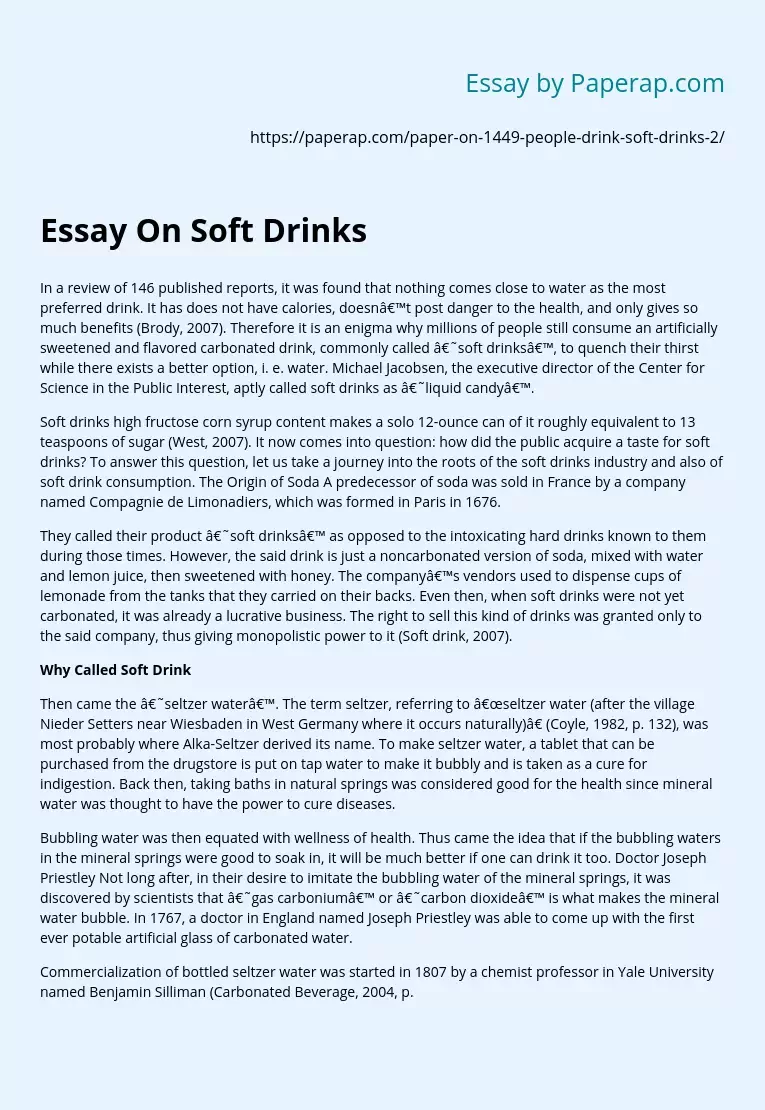Soft Drinks Are “Liquid Candy”
In a review of 146 published reports, it was found that nothing comes close to water as the most preferred drink. It has does not have calories, doesn’t post danger to the health, and only gives so much benefits (Brody, 2007). Therefore it is an enigma why millions of people still consume an artificially sweetened and flavored carbonated drink, commonly called “soft drinks”, to quench their thirst while there exists a better option, i. e. water. Michael Jacobsen, the executive director of the Center for Science in the Public Interest, aptly called soft drinks as “liquid candy”.
Soft drinks high fructose corn syrup content makes a solo 12-ounce can of it roughly equivalent to 13 teaspoons of sugar (West, 2007). It now comes into question: how did the public acquire a taste for soft drinks? To answer this question, let us take a journey into the roots of the soft drinks industry and also of soft drink consumption. The Origin of Soda A predecessor of soda was sold in France by a company named Compagnie de Limonadiers, which was formed in Paris in 1676.
They called their product ‘soft drinks’ as opposed to the intoxicating hard drinks known to them during those times. However, the said drink is just a noncarbonated version of soda, mixed with water and lemon juice, then sweetened with honey. The company’s vendors used to dispense cups of lemonade from the tanks that they carried on their backs. Even then, when soft drinks were not yet carbonated, it was already a lucrative business.
The right to sell this kind of drinks was granted only to the said company, thus giving monopolistic power to it (Soft drink, 2007).
Then came the “seltzer wate”’. The term seltzer, referring to “seltzer water (after the village Nieder Setters near Wiesbaden in West Germany where it occurs naturally)” (Coyle, 1982, p. 132), was most probably where Alka-Seltzer derived its name. To make seltzer water, a tablet that can be purchased from the drugstore is put on tap water to make it bubbly and is taken as a cure for indigestion. Back then, taking baths in natural springs was considered good for the health since mineral water was thought to have the power to cure diseases.
Bubbling water was then equated with wellness of health. Thus came the idea that if the bubbling waters in the mineral springs were good to soak in, it will be much better if one can drink it too. Doctor Joseph Priestley Not long after, in their desire to imitate the bubbling water of the mineral springs, it was discovered by scientists that ‘gas carbonium’ or ‘carbon dioxide’ is what makes the mineral water bubble. In 1767, a doctor in England named Joseph Priestley was able to come up with the first ever potable artificial glass of carbonated water.
Commercialization of bottled seltzer water was started in 1807 by a chemist professor in Yale University named Benjamin Silliman (Carbonated Beverage, 2004, p. 8495). This sparkling water was presumed to have healing properties such as aiding digestion, and calming the nerves. Soda comes to America It was in the year 1798 when the coinage of the term “soda water” happened. While still in London, John Matthews had learned from inventor Joseph Bramah the basics about making carbonic acid gas and building carbonating machinery. In 1831, John Matthews immigrated to the United States where he invented his apparatus for making carbonated water.
He was called the Father of American Soda Water by the soda fountain industry and most historians credit him in bringing soda to America. He then began supplying carbonated water to establishments in the New York area where he immigrated (American Heritage, 1947, p. 11-12). After 1830, sweetened and flavored (lemon-lime, grape, orange) carbonated drinks became popular (Carbonated Beverage, 2004, p. 8495). Among these was carbonated lemonade, also known as “ginger ale”, which heralded the advent of the popular carbonated drinks or sodas of today – “soft drinks”.
Soft Drinks Are “Liquid Candy”. (2019, Dec 05). Retrieved from https://paperap.com/paper-on-1449-people-drink-soft-drinks-2/

